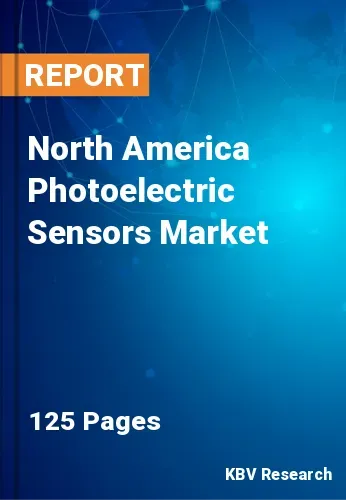The North America Photoelectric Sensors Market would witness market growth of 5.7% CAGR during the forecast period (2023-2030). In the year 2019, the North America market's volume surged to 9,466.5 thousand units, showcasing a growth of 5.7% (2019-2022).
A photoelectric sensor is a technical position sensor that detects an object's distance, colour, absence, or presence using an infrared light transmitter and photoelectric receiver. The primary applications of these sensors are industrial, including detecting position misalignments and monitoring conveyor position control and product presence. By enhancing operational efficiency and reducing process time, they effectively improve productivity. The military and defence sectors employ these intelligent sensors for surveillance and security purposes by identifying targets, as they are tolerant of hazardous, filthy environments and long-range measurements and require minimal maintenance. Furthermore, these are implemented in elevator cage detection and automotive detection in parking lots due to their dependability, affordability, and compact size, as well as their extended lifespan and decreased downtime.
Additionally, the photoelectric sensor eliminates the need for external wiring in the circuit. As a result, it remains impervious to potential environmental disturbances, including pollen and mist, which scatter light. Because additional developments in nanotechnology enable precise and high-resolution measurements of distance and position, the market of photoelectric sensors is expected to expand exponentially over the next few years.
According to the Canada Energy Regulator (CER), renewables will reach 12% of total power generation by 2035. Wind is Canada's second-largest source of renewable energy, with an installed capacity of 13,588 MW in 2021, with Ontario (5,436 MW), Québec (3,882 MW), and Alberta (1,685 MW) the leading provinces. The total solar photovoltaic (PV) power installed capacity was over 2,600 MW 2021. These sensors are utilized in weather monitoring systems at renewable energy sites. These sensors measure various atmospheric parameters, such as ambient light levels, temperature, and humidity. Accurate weather data helps optimize energy production and anticipate fluctuations in renewable energy generation. As a result, these aspects will boost the market growth in the coming years.
The US market dominated the North America Photoelectric Sensors Market by Country in 2022 and would continue to be a dominant market till 2030; thereby, achieving a market value of $605.1 Million by 2030. The Canada market is experiencing a CAGR of 8% during (2023 - 2030). Additionally, The Mexico market would exhibit a CAGR of 7.1% during (2023 - 2030).
Based on Technology, the market is segmented into Retro-reflective, Diffused, and Thru-beam. Based on Application, the market is segmented into Automotive, Electronics & Semiconductor, Packaging, Military & Aerospace, and Others. Based on countries, the market is segmented into U.S., Mexico, Canada, and Rest of North America.
Free Valuable Insights: The Photoelectric Sensors Market is Predict to reach $2.8 Billion by 2030, at a CAGR of 6.3%
The market research report covers the analysis of key stake holders of the market. Key companies profiled in the report include Omron Corporation, Panasonic Corporation, Rockwell Automation, Inc., Eaton Corporation Plc., Keyence Corporation, Schneider Electric SE, Autonics Corporation, SICK AG, Balluff GmbH, and IFM Electronic GmbH.
By Technology (Volume, Thousand Units, USD Billion, 2019-2030)
By Application (Volume, Thousand Units, USD Billion, 2019-2030)
By Country (Volume, Thousand Units, USD Billion, 2019-2030)

Our team of dedicated experts can provide you with attractive expansion opportunities for your business.

